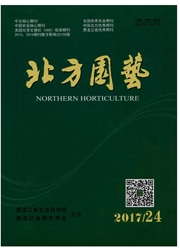

 中文摘要:
中文摘要:
针对温室土壤盐渍化引起的作物盐害加剧问题,以温室主栽作物黄瓜为试材,在100mmol/L NaCl处理条件下,设计0、20、40、60mmol/L CaCl2处理,研究了不同浓度钙源加入对黄瓜幼苗生长的渗透调节物质、抗氧化酶系统以及光合特性的影响。结果表明:盐处理10d后,加入20、40mmol/L CaCl2处理较CK处理显著降低了超氧化物歧化酶(SOD)和过氧化物酶(POD)活性,但降低比率〈10%;外源加入20、40mmol/L CaCl2可显著降低丙二醛(MDA)含量、相对电导率和伤害度,显著增加可溶性糖含量;加入CaCl2处理较CK处理显著降低植株的光合特性,其中20mmol/L CaCl2处理显著降低了植株水分利用效率。综合分析表明,外源加入20mmol/L CaCl2可显著缓解盐分对黄瓜幼苗的伤害,提高其耐盐性。
 英文摘要:
英文摘要:
Soil salinization has caused salt damage to crops in greenhouse.Taking cucumber as material,the effects of different concentrations of calcium(Ca^2+)(0,20,40,60 mmol/L CaCl2) on the osmotic regulation substance of growth,antioxidant system and photosynthetic characters of cucumber treated with 100 mmol/L NaCl were studied.The results showed that the POD and SOD activity by 20 and 40 mmol/L CaCl2 treatments were lower than CK treatments,but the rate was lower than 10%,relative leaf electrical conductivity,the degree of leaf damage,and leaf MDA content were lower than CK treatment by 20 and 40 mmol/L CaCl2 treatments,and whose soluble sugar content were also higher than CK treatment.Supplying Ca^2+ could reduce the photosynthetic indices,and supplying 20 mmol/L CaCl2 could reduce water use efficiency.So supplying 20 mmol/L CaCl2 could relieve salt damage to cucumber seedlings,increased the cucumber salt tolerance.
 同期刊论文项目
同期刊论文项目
 同项目期刊论文
同项目期刊论文
 期刊信息
期刊信息
